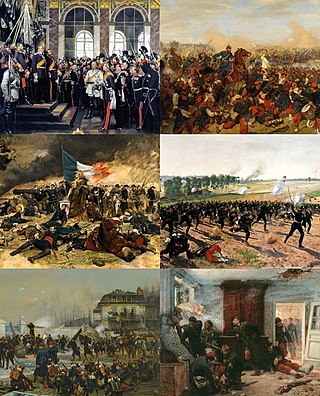
The Franco-Prussian War or Franco-German War, often referred to in France as the War of 1870, was a conflict between the Second French Empire and the North German Confederation led by the Kingdom of Prussia. Lasting from 19 July 1870 to 28 January 1871, the conflict was caused primarily by France's determination to reassert its dominant position in continental Europe, which appeared in question following the decisive Prussian victory over Austria in 1866. According to some historians, Prussian chancellor Otto von Bismarck deliberately provoked the French into declaring war on Prussia in order to induce four independent southern German states—Baden, Württemberg, Bavaria and Hesse-Darmstadt—to join the North German Confederation; other historians contend that Bismarck exploited the circumstances as they unfolded. All agree that Bismarck recognized the potential for new German alliances, given the situation as a whole.
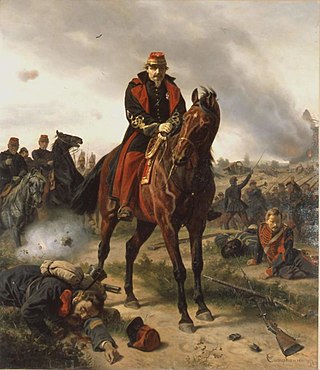
The Battle of Sedan was fought during the Franco-Prussian War from 1 to 2 September 1870. Resulting in the capture of Emperor Napoleon III and over a hundred thousand troops, it effectively decided the war in favour of Prussia and its allies, though fighting continued under a new French government.

The siege of Antwerp was an engagement between the German and the Belgian, British and French armies around the fortified city of Antwerp during World War I. German troops besieged a garrison of Belgian fortress troops, the Belgian field army and the British Royal Naval Division in the Antwerp area, after the German invasion of Belgium in August 1914. The city, which was ringed by forts known as the National Redoubt, was besieged to the south and east by German forces.

The Battle of Liège [also French: Bataille de Liège] was the opening engagement of the German invasion of Belgium and the first battle of the First World War. The city of Liège was protected by a ring of modern fortresses to form the Fortified position of Liège, one of several fortified cities to delay an invasion to allow troops from the powers which had guaranteed Belgian neutrality to assist the Belgian Army in the expulsion of the invaders.

The siege of Metz was a battle fought during the Franco-Prussian War from August 19 to October 27, 1870 and ended in a decisive allied German victory.

The siege of Paris took place from 19 September 1870 to 28 January 1871 and ended in the capture of the city by forces of the various states of the North German Confederation, led by the Kingdom of Prussia. The siege was the culmination of the Franco-Prussian War, which saw the Second French Empire attempt to reassert its dominance over continental Europe by declaring war on the North German Confederation. The Prussian-dominated North German Confederation had recently emerged victorious in the Austro-Prussian War of 1866, which led to the questioning of France's status as the dominant power of continental Europe. With a declaration of war by the French parliament on 16 July 1870, Imperial France soon faced a series of defeats at German hands over the following months, leading to the Battle of Sedan, which, on 2 September 1870, saw a decisive defeat of French forces and the capture of the French emperor, Napoleon III.

The siege of Belfort was a 103-day military assault and blockade of the city of Belfort, France by Prussian forces during the Franco-Prussian War. The French garrison held out until the January 1871 armistice between France and the German Empire obligated French forces to abandon the stronghold in February 1871.
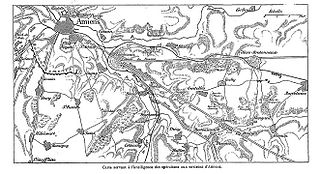
The Battle of Amiens, also known as the Battle of Villers-Bretonneux, was fought on 27 November 1870 between French and Prussian forces during the Franco-Prussian War (1870–1871). It ended in a Prussian victory, forcing the French to retreat and allowing the Prussians to capture Amiens, France.

The XIV Army Corps / XIV AK was a corps level command of the German Army before and during World War I. It was, effectively, also the army of the Grand Duchy of Baden, which, in 1871, had been integrated into the Prussian Army command structure, as had the armies of most German states. Both divisions and the bulk of the corps' support units were from the grand duchy. The corps was established in 1870, after the Siege of Strasbourg.
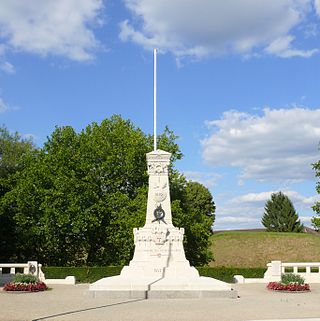
The siege of Toul was the siege of the fortified French town of Toul from 16 August to 23 September 1870 by Prussian, Bavarian and Württemberg forces during the Franco-Prussian War. Toul controlled a railway line leading to Germany and it was vital for the Germans to secure it to resupply and reinforce their armies in northern France.

The siege of Namur was a battle between Belgian and German forces around the fortified city of Namur during the First World War. Namur was defended by a ring of modern fortresses, known as the Fortified Position of Namur and guarded by the 4th Division of the Belgian Army. The purpose of the fortified Belgian cities was to delay an invasion force until troops from the states guaranteeing Belgian independence came to their aid. The French Fifth Army planned to counter-attack while the Germans were besieging Namur.

Jean-Jacques Alexis Uhrich, was a French général de division. He was the great uncle of Général d'armée Maurice Gamelin (1872–1958). Military governor of the city of Strasbourg in 1870, Uhrich is best known for his service during the Franco-Prussian War (1870–1871) as the commander of French forces during the Siege of Strasbourg and for surrendering the city to German forces.
The siege of Marsal was a battle of the Franco-Prussian War on August 13 to 14 between the French Empire and the combined German forces of Prussia and Bavaria in Marsal. Under the command of Lieutenant General Jakob von Hartmann, after replacing the Prussian 4th Cavalry Division, II Corps of the Kingdom of Bavaria forced the surrender of the French Empire's defenses, after a brief resistance by the French troops stationed at the fortress. Marsal fell to the German army in the same period as the French fortresses of Lichtenberg, La Petite-Pierre and Vitry. With the quick victory of the Bavarian army at Marsal, the road from Dieuze to Nancy was open to the Germans. In addition, the siege also brought the Germans a lot of raw materials for the war, as well as hundreds of prisoners.

The siege of Montmédy was a battle of the Franco-Prussian War at the small commune of Montmédy, in the Meuse, it was besieged by the army of the German coalition. Defended by the 57th Line Infantry Regiment, the Garde Mobile and elements of other units, it surrendered on December 14, 1870.
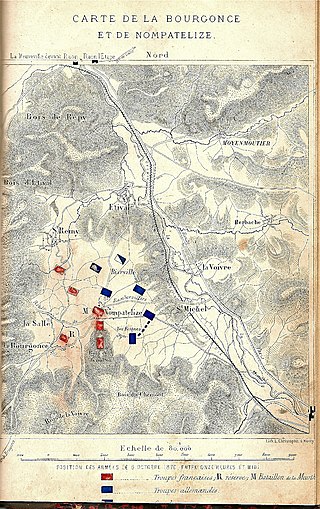
The Battle of Nompatelize, also known as the Battle of Etival, was a battle of the Franco-Prussian War on 6 October 1870, between Etival and Nompatelize in the province of Vosges from Strasbourg 64 km southwest. This battle marked the first major crackdown of franc-tireur operations in the Vosges region by the XIV Corps of the Prussians by Minister August von Werder in early October 1870. In matches fiercely this, A force of the Army of Rhône of the French Republic under the command of General Louis-François Dupré, who predominated to markedly document in terms of troop numbers, and attacked 6 infantry battalions of the Grand Duchy of Baden under the command of General Alfred von Degenfeld which were part of the XIV Corps, but were defeated. Compared to the casualties of the German military, the losses of the French side in this battle were much greater. After seven hours of fighting, the French were forced to flee in turmoil to Bruyeres and the Rambervillers. The Battle of Etival contributed to General Werder wiping out the French from Alsace.
The siege of Verdun was a battle fought in France during the Franco-Prussian War from 13 October until 8 November 1870.
The Battle of Ognon was a battle in the Franco-Prussian War, which took place on October 22, 1870, at the Ognon River. In this battle the Prussian XIV Corps under the command of General Karl August von Werder, which also consisted of a division of the Grand Duchy of Baden, attacked elements of the French Army of the Rhine commanded by General Albert Cambriels. The Germans captured a large number of French prisoners. The German victory in the Battle of Ognon decided the fate of the Army of the Rhine, at least within two weeks thereafter.
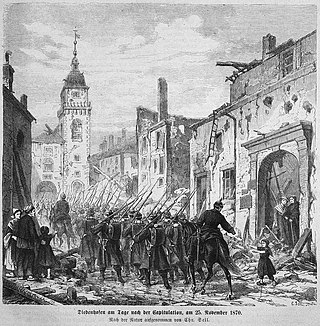
The siege of Thionville was a battle of the Franco-Prussian War which occurred in Thionville of the Moselle from November 13 to November 24, 1870. The small French garrison repulsed an attempted attack on August 14. It was subjected to a blockade and then besieged from November 13. After the capitulation of Metz, on October 28, 1870, the Prussians move part of their powerful artillery to Thionville. Bombed from November 22, the square surrendered on November 24. The capture of Thionville and that of Montmédy a month later gave the Germans control of the railroad to the Picardy front.
The siege of Mézières was a siege battle during the Franco-Prussian War, it took place from November 17, 1870 until January 2, 1871, in Mézières-en-Gâtinais which is located on the banks right of the river Meuse in France. After suffering from a German artillery strike, the French army at Mézières under the command of Colonel Vernet, surrendered to Germany under the command of Major General Wilhelm von Woyna on January 2, 1871. Although lasting just over a day, German artillery bombardment caused French defenders and civilians in Mézières heavy losses. With the victory, the Germans captured many French officers and soldiers, with many cannons and supplies from the enemy's reserves. Not only that, the victory at the Siege of Mézières made the German army have complete dominance of the railway line in the north extending from Metz and Mézières to Paris, capital of France.

The siege of Rocroi was a battle of the Franco-Prussian War, it was held in January 4 to the 6th, 1871 at Rocroi which was a bastion of France located to the west of Sedan. After an artillery fire by the Prussian army, the officer commanding the French troops at Rocroi was forced to surrender the Division Militia under General Schuler and Sendan and Wilhelm von Woyna. With the success of the Siege of Rocroi, the military spectrum was obtained on their hands were hundreds of prisoners along with many stocks, costumes and contemporary heavyweight artillery of the French. During this siege, the town of Rocroi was heavily destroyed. The fall of Rocroi marked one of the German army's consecutive victories in the war.




















